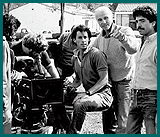The Maine-based International Film & Television Workshops celebrate two decades of educational image-making.
Rockport is a charming harbor village nestled along the rugged coastline of Maine. Two diverse industries flourish in this tiny community: lobster fishing and photographic education. For the past two decades, Rockport has served as home base for the International Film & Television Workshops (IFTW), a place where thousands of aspiring filmmakers have benefitted from the teachings of industry experts.
The IFTW began as a summer program for creative filmmakers and photographers, but has grown into a year-round center for image-makers. The program recently became authorized to grant college credit, and formed Rockport College, where students can earn an Associate Arts or Master of Fine Arts degree. The entire program, including all of the summer and fall offerings, is detailed in course catalogues published every February one for the still photography classes and another specializing in film and video work for motion pictures. A separate catalogue is available on the IFTW web site (www.MEWorkshops.com).
In addition to the Still Photography and Motion Picture classes, others are offered in the categories of Documentary Film, Advanced Video, Corporate Video, TV Commercials and Television. The film and video catalogue describes a number of longer programs as well: the Summer Film School, a Resident Filmmakers program, and even a series of two-week summer studies for high school filmmakers, actors and photographers. The IFTW also conducts international seminars in Tuscany, Italy; Provence, France; and Oaxaca, Mexico.
This extensive program had more modest beginnings in 1976, when still photographer David Lyman created the Maine Photo-graphic Workshops. Lyman, who continues to serve as the program's director, says that his efforts stemmed from his passion for visual imagery. "The Workshops were the result of a personal experience that I had in Aspen, Colorado, in 1972," he says. "I was 32 years old and a very energetic, enthusiastic photographer and magazine writer working in the ski business. While my work was exciting and glamorous, it was not fulfilling my soul. I thought I would love to photograph the kind of stories I saw in National Geographic, stories about people and societies, and anthropology and visual culture. I heard that Robert Gelka, who was the director of photography at National Geographic at the time, was going to give a 10-day workshop at a place called The Center of the Eye in Aspen. I sent off my portfolio, my deposit, and application, and was accepted. I went with great anticipation of showing Mr. Gelka my portfolio. I brought my passport, figuring he was going to say, 'All right, I've got a job for you, son. I want you to go to Afghanistan. When can you leave?' And I'd say, 'Tomorrow, sir.'
"On the second day, I had the opportunity to present my portfolio to Mr. Gelka. Halfway through the review, he closed it, pushed it back to me, and said, 'Do you earn a living with this stuff?' and then turned to the next student."
Disappointed by this rebuff, Lyman went back to his usual routine. "I continued to do the same thing that I'd always been doing, but in the midst of my depression an idea was born. I told my colleagues that I was going to start my own [workshop]. And they said, 'My God, where?' I replied, 'Up on the coast of Maine.' They thought it was a marvelous idea. I just threw that out as a passing thing; I'd thought about it, but not seriously. But they said, 'That's a fantastic idea. It's amazing nobody's thought about it before.' In the beginning, the idea didn't involve motion pictures, just still photography.
"But the core of the idea was the notion that image-makers work intuitively. It's not an intellectual process. If we start intellectualizing, it's usually over a few beers at a bar, when the day's work is over. The rest of the time, we're operating on automatic pilot. We don't really think about what we're doing because we're too busy responding to what's going on around us. The foundation of my thinking was to set up a program that would teach intuitively, not intellectually."
As Lyman developed his plans for what would become the IFTW, he discovered something very unexpected: motivated people working together in this idyllic environment and spending a week with a veteran professional could absorb and produce a tremendous amount of creative energy. This happened through a hands-on, uninterrupted and intuitive learning environment. Students were immersed in their studies from the time they awoke in the morning, through mealtimes and on into the night. The formula worked so well with still-photography courses that Lyman decided to add filmmaking studies.
[ continued on page 2 ]
